Some Applications of Trigonometry
Solving Real World Problems Involving Heights and Distances
Tushar is looking at the top of a tree. The height of Tushar is 1.6 m. The distance between the foot of the tree and Tushar is 12 m. The line joining his eye and the top of the tree makes an angle of 30° with the horizontal line. Tushar wants to know the height of the tree.
Can we help him?
In this way, we can find the unknown distance or height using the concept of trigonometric ratios. Let us discuss some examples based on problems related to heights and distances.
Example 1: A boy is looking at a ball on the ground from the top of a building which is ![]() high. If the distance between his eye and the ball is 40 m, then what will be the angle of depression and the distance between the foot of the building and the ball?
high. If the distance between his eye and the ball is 40 m, then what will be the angle of depression and the distance between the foot of the building and the ball?
Solution:
The diagram of this situation can be drawn as follows

Let the angle of depression be θ and the distance between the foot of the building and the ball be x m.
It is given that,
AC = line of sight = 40 m
AB = height of the building = ![]()
The angle of depression = ∠ACB = θ
Now, in right-angled triangle ABC, we have
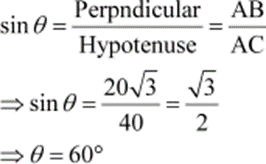
Thus, the angle of depression is 60°.
Again, in , we have
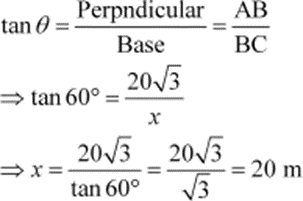
Thus, the distance between the foot of the building and the ball is 20 m.
Example 2: A man is standing at a distance of 20 m at a point C in front of a lamp post AB. The angle of elevation at point C is 60º. Find the distance covered by the man if he walks away from the lamp post so that the angle of elevation becomes 30°.
Solution:
The figure of this situation can be drawn as follows.

Let the man walk x m and reach at point D. Let the height of the lamp post AB be h. Now, in right-angled triangle ABC, we have

Thus, the height of the lamp post is . In , we have
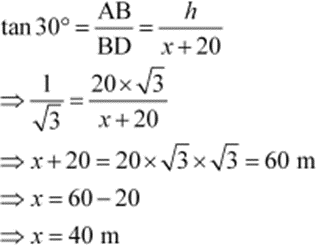
Thus, the required distance is 40 m.
Example 3: Two buildings are at a distance of ![]() from each other. A boy standing at the top of the smaller building is looking at the top and bottom of the other building. The angle of elevation and depression are 60° and 30° respectively. What will be the heights of the two buildings?
from each other. A boy standing at the top of the smaller building is looking at the top and bottom of the other building. The angle of elevation and depression are 60° and 30° respectively. What will be the heights of the two buildings?
Solution:
The given situation can be represented geometrically by the following figure.

Let the height of smaller building be x m and larger building be y m.
Here, the angle of elevation, i.e., ∠CAB = 60°
and the angle of depression, i.e., ∠BAD = 30°.
∠BAD and ∠ADE are alternate interior angles.
∴ ∠ADE = ∠BAD
= 30°
From the figure, we have
BD = AE = x
∴ BC = CD − BD
= y − x
Now, in right-angled![]() , we have
, we have
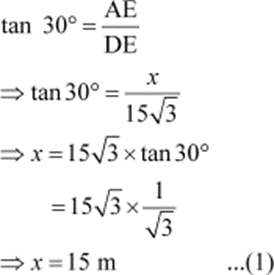
Now, in right angled ![]() , we have
, we have
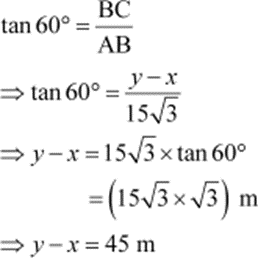
Using equation (1), we have
y − 15 = 45
⇒ y =45 + 15 = 60 m
Thus, the heights of the two buildings are 15 m and 60 m respectively.

 ACERISE INDIA
ACERISE INDIA
